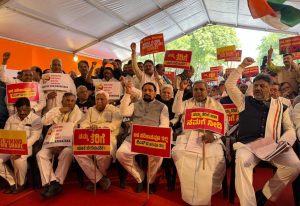After Finance Minister Nirmala Sitharaman presented India’s annual budget early this month, leaders from the southern states protested over their falling share in the country’s tax revenues.
The dispute appears poised to escalate in the run-up to parliamentary polls due in a few months, but it’s a rather old one.
Although the five states of south India – Telangana, Andhra Pradesh, Karnataka, Kerala and Tamil Nadu – only account for about a fifth of India’s population, they contribute almost a third of the national GDP. But under India’s relatively centralized federal system, a significant chunk of public tax revenues generated by that economic activity ends up not in the hands of the states but in the union government’s exchequer in New Delhi.
The union government then distributes those funds among India’s 29 states based on the recommendations of a Finance Commission constituted by the president. Those recommendations are based on multiple factors, including population and income levels.
The rationale for this uneven distribution of revenues is to help lower income states and more populous states access more public funds. But on both counts, southern states have long been at a disadvantage.
Owing to successful family planning and better socioeconomic outcomes over the last few decades, southern India’s share of the population has fallen drastically. In 1951, those states accounted for over 26 percent of India’s population. By 2022, that figure had steadily fallen to under 20 percent, according to census estimates. In the meantime, the South’s income levels grew noticeably faster than the national average.
These trends have had an inevitable impact on the funds that the union government devolves to the southern states. In 2014-15, the five southern states received over 18 percent of the total federal tax revenue devolved to the states. That number was already disproportionately smaller than the South’s share of India’s population and its share of the national GDP. But a decade later, it has fallen to under 16 percent.
Things came to a head in 2018 when the Finance Commission changed the way it measures population. In order to avoid penalizing the southern states for slowing their population growth, the Finance Commission previously calculated the population part of its equation by using a combination of the 1971 and 2011 census data. But in 2018, the Commission decided to use data from only the 2011 census, thereby reducing the South’s share of federal funds considerably.
In recent years, the inter-regional quarrel has been vitiated further by a growing perception in the South that its pluralistic, multicultural identity is under attack. Several leaders of Prime Minister Narendra Modi’s Bharatiya Janata Party, which dominates north Indian constituencies but has limited presence in the south, have been promoting the use of Hindi as a national language. But Hindi is not widely spoken anywhere in the South.
Regardless of these nuances, the heavy centralization of fiscal resources is terrible for India’s economy as a whole. Over the last couple of decades, foreign businesses and investors operating in India have often gravitated toward states that have provided more efficient governance. Modi’s own promotion of a “cooperative and competitive federalism” has depended on the various states’ ability to develop infrastructure, uphold the rule of law, and conduct state-level trade diplomacy. All of that requires not just fiscal autonomy but also an incentive to create economic growth – an incentive that is undercut if state governments don’t get to access the fruits of their growth.
South India’s economic success is also crucial to poverty alleviation in North India. Over the years, the southern states have seen an immense influx of north Indian migrants who have sought opportunities in the South’s economic growth. This inter-state migration has generated significant remittances by many lower-skilled workers back to their families in the North.
In a country as vast and diverse as India, centralization or homogenization of any kind – fiscal, political or cultural – is a recipe for economic failure. India needs more federalism, not less.

































